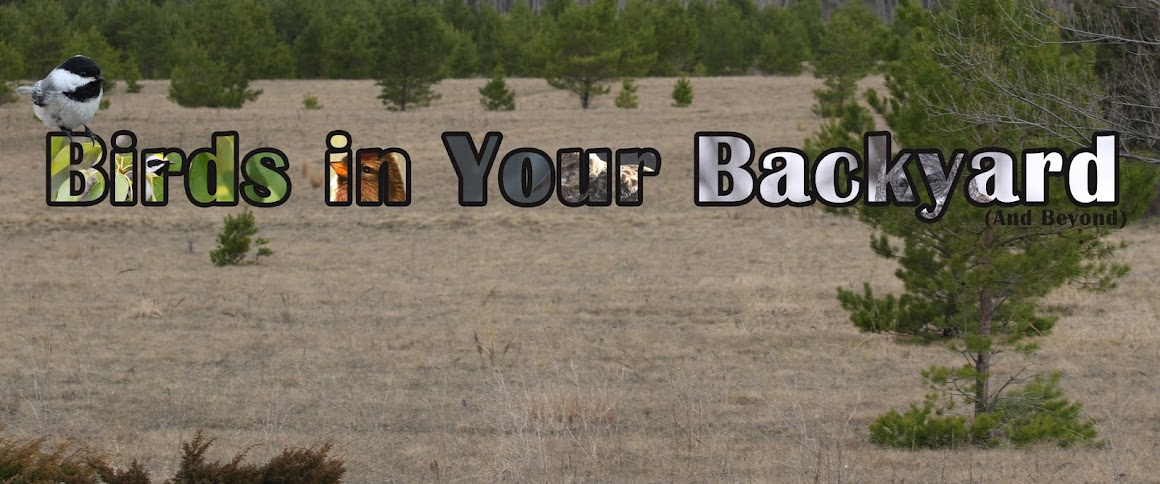At last. The full story of the Long-eared Owls nesting in our yard in 2015. This is a joint post with Christian Artuso, who came over several times to photograph the owls. Many of these photos are his and are used with permission.
In the Spring of 2014 we were pleasantly surprised by a pair
of Long-eared Owls that showed up, right in our backyard! We discovered them
mid-April, and they stuck around for a month or so, right in our yard, but they
disappeared and we didn’t see them after that. I suppose they spent the spring
in our yard, but didn’t nest here.
This year, 2015, in late March we again discovered them,
right in our back yard. In a month or two, we discovered a nest, in the back
forest, with three white, fluffy owlets!
The next day we found a dead owlet beneath the nest, perhaps
there was only two left. It wasn’t until a bit later that we found that there
were still three left, so it the beginning there was four.
By the beginning of June, the owlets were branching. This
means they are hopping from branch to branch, and flapping their wings, the
first step towards flight. In the day the young owls would sit in the trees,
quite low to the ground, which was ideal for photos. They quickly grew up and
would beg for food endlessly. Soon they were okay at flying (though still very
noisy). Christian came over several times to photograph them.
On March 21st we first found the Long-eared Owls this year,
there was still snow on the ground. It was very exciting to have the owls again,
two years in a row.
May 26th William saw three owlets in a nest. The nest was in
the back spruce forest, just off of our property, on the neighbors. We later
discovered the nest was only about 10 meters away from the Cooper's Hawk nest.
It is quite satisfying to enter 5 Long-eared Owls on eBird.
 |
| Long-eared Owlets and adult |
Soon the owls were branching, and then we had excellent
opportunities for photography. Of course we still had to be very careful
to watch them for any signs of disturbance and to make sure that their body
posture was still relaxed. Once while we were taking pictures of a young owl
with Christian, we didn't even notice an adult owl which was several feet away
from us. They are masters of disguise, blending in with the tree trunks. We
had to back away very slowly.
 |
 |
| Long-eared Owl, talons |
As time went on, their flight feathers began to really show, and we saw them
flapping their wings, and jumping from branch to branch. At this time, the
three grey fledglings stayed around a particular row of pine trees. They stayed
around that small area for quite a while. I like to call this area Zone 2, and
the nest area Zone 1. When they were very young, they stayed around Zone 1, in
the Spruce forest, when they were a bit older, they stayed around Zone 2, and
for the rest of the time they were here, Zone 3, which was mixed deciduous
forest closer to our house.. When the owls were still in Zone 2, in the night
they went to Zone 3 some of the time.
 |
| Long-eared Owl immature |
Here all three of them are.
 |
| Long-eared Owl immature |
They began going to Zone 3 a lot more, but often roosted in
Zone 2. Then they began quickly changing color, in the matter of a few days
they were looking a bit orange, with splotches of black.
 |
| Long-eared Owl immature |
A week later, they looked more like an adult, and could fly
quite well.
 |
| Long-eared Owl immature |
In another week or two, Christian came over to photograph
the owls, and to help us with night observations. We started in the
evening, and went into the night, so we got some daytime pictures,
and a few night pictures.
By this time they looked almost exactly like adults.
 |
| Long-eared Owl immature |
 |
| Long-eared Owl immature |
 |
| Long-eared Owl immature |
 |
| Long-eared Owl immature |

 |
| The only flight shot we got. |
They looked like adults, and in the night they were flying
all over, very quickly. They were still begging, last I saw them, which was late
in July, just before we left to the Whiteshell for camping. The young owls were
such a treat, and a very special thing I will remember for a very, very long
time. In all, we had Long-eared Owls right in our backyard for 5 months this
year, a really spectacular thing. Watching them grow up, learn to fly, it was
truly incredible.







































